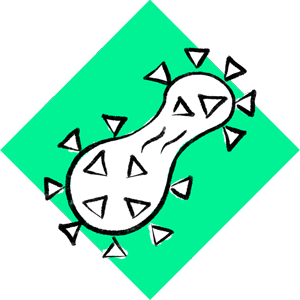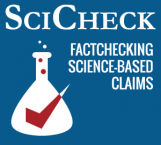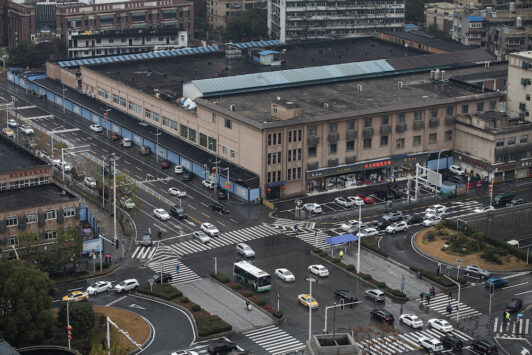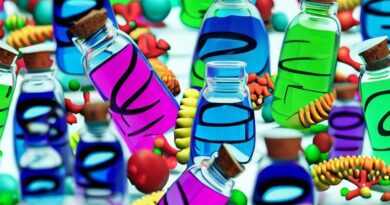No ‘Bombshell’ On COVID-19 Origins, U.S. Intelligence Rebuts Claims About ‘Sick’ Lab Workers
SciCheck Digest
It remains unknown how the virus that causes COVID-19 originated, but many scientists think a natural spillover is most likely. Online posts have cited unnamed sources to claim that scientists in Wuhan, China, were the first to get sick with COVID-19. But U.S. intelligence says the researchers’ symptoms were non-specific or inconsistent with COVID-19, and the information has no bearing on the origin of the pandemic.

Full Story
Since the beginning of the pandemic, people have wondered how SARS-CoV-2, the coronavirus that causes COVID-19, came to be. Did it come from a wild or farmed animal, infected upstream by a bat, as previous pandemics and the early case ties to a wet market would suggest? Or did it come from a lab, particularly the Wuhan Institute of Virology, or WIV, which is across the river from the market and does research on coronaviruses?

Scientists investigating the origins of COVID-19 have argued in favor of a natural origin, given that the earliest cases, including those with no known connection to the market, geographically cluster around the market — and genetic proof that susceptible animals were illegally sold there. A genomic analysis also indicates there were two early lineages of the virus that spilled over separately — a scenario much harder to reconcile with a lab leak. Without a documented intermediate animal, however, the evidence doesn’t rule out the possibility of a lab origin.
A rumor that one or more WIV workers might have fallen ill with a COVID-like disease in the fall of 2019 has long underpinned claims supporting the lab leak theory. But as we explained previously, the veracity and significance of these alleged reports is unclear, as Wuhan was experiencing a surge of influenza at the time. In October 2021, U.S. Intelligence indicated that such claims had not been confirmed, and in any event, the information was “not diagnostic of the pandemic’s origins.”
But ahead of the anticipated release of additional declassified material pertaining to the WIV, social media was abuzz with revived claims about the alleged sick workers.
On June 10, the Times in London published a story mentioning the workers and promoting the baseless claim that the coronavirus is the result of bioweapons research. Laura Ingraham covered it on Fox News, billing the story as a “bombshell,” even though U.S. Intelligence doesn’t give any credence to that idea. A clip of Ingraham’s show, which regularly gets more than 1 million viewers, was viewed on Facebook more than 100,000 times.
Then, on June 13, a Substack post, citing anonymous government sources, claimed to know with “100%” certainty the identity of three “patients zero” who manipulated viruses in the lab. (The Wall Street Journal later published a story saying it had “independently confirmed” the names, but did not offer any evidence other than unnamed sources.) A Facebook post a few days later stated that the “1st person who got sick worked at the Wuhan Lab.”
In a June 18 interview on Fox News, clips of which were shared on Facebook, Republican Sen. Rand Paul repeated the supposed findings of the Substack post, calling them a “big deal.”
“In the article, they reveal that the first people to get sick from COVID were three scientists, that they worked in the Wuhan lab with the bat scientist Dr. Shi,” he said. “In fact, one of them … the first person to get sick, was one of the ones creating these new viruses, viruses not found in nature. This is the gain-of-function research. And so this essentially closes the deal.”
Paul, who has been a fierce critic of research that might be construed as gain-of function, then suggested the information might be confirmed the next day, when the Director of National Intelligence was expected to release additional declassified information, as ordered by the COVID-19 Origin Act of 2023.
But in its report, which arrived belatedly on June 23, the U.S. Intelligence Community, or IC, does not substantiate any of these details.
“While several WIV researchers fell mildly ill in Fall 2019,” the report reads, “they experienced a range of symptoms consistent with colds or allergies with accompanying symptoms typically not associated with COVID-19, and some of them were confirmed to have been sick with other illnesses unrelated to COVID-19.”
The 10-page report, which does not name any individuals, says the IC “continues to assess that this information neither supports nor refutes either hypothesis of the pandemic’s origins because the researchers’ symptoms could have been caused by a number of diseases and some of the symptoms were not consistent with COVID-19.”
The same day of the release, Science reported that two of the accused WIV workers denied being sick in the autumn of 2019, with one of them calling the allegations “ridiculous.” Lab head Shi Zhengli, who has been the target of many of the lab leak scenario claims, further told Science that none of the three accused workers even worked with live viruses, and that antibody testing in March 2020 showed that no one in her lab had evidence of prior infection.
Some scientists have noticed that for the three named scientists, their names do not follow the same ordering convention. While two are written with their family names second, one is written with the family name first, as is standard in China. The individual with the reverse convention was a student who had published a thesis with her name in that order; the thesis had previously become fodder for lab leak proponents online. This suggests, the scientists say, that the names were simply plucked from papers by people who are not familiar with Chinese.
Evolution of the ‘Sick’ Workers Rumor
Various versions of the “sick” lab workers rumor have been circulating for at least three years.
As French biologist Flo Débarre detailed in a Twitter thread, the first mention of a sick worker came in April 2020, when John Roberts of Fox News said during a coronavirus briefing that “multiple sources are telling Fox News” that the pandemic began with a WIV intern, who infected her boyfriend and then visited the wet market. (Débarre is a co-author on an unpublished report that analyzed sequences from the wet market, proving that animals susceptible to SARS-CoV-2 were present at the time.)
The first official recognition of the rumors was in January 2021, when in the waning days of the Trump administration the State Department put out a “fact sheet” stating that the government “has reason to believe that several researchers inside the WIV became sick in autumn 2019, before the first identified case of the outbreak, with symptoms consistent with both COVID-19 and common seasonal illnesses.”
Some Republicans and Trump administration officials had been promoting the idea of a lab leak since the spring of 2020, sometimes claiming there was clear evidence of it, but failing to provide any support.

Since then, most iterations of the ‘sick’ worker story, including an influential Wall Street Journal report in May 2021, refer to three WIV workers, although other details have shifted and changed over time. Sometimes it’s specified that all worked on gain-of-function research, or all in the same lab, but other times not. Sometimes they are sick in November 2019; in other versions, it’s October. The illnesses are variously described as respiratory illnesses or consistent with COVID-19, but sometimes include details that could be more diagnostic of COVID-19, such as patients losing their senses of smell and having ground-glass opacities in their lungs. Some versions say the workers were hospitalized or visited a hospital for their symptoms, while others do not. And some add other unsubstantiated details, such as a relative of a worker dying or there being body bags outside of the WIV and the workers having gone missing.
The provenance of all these claims is unclear, but a couple of former Trump officials consistently pop up as providing information to journalists, including David Asher, a former State Department adviser, and John Ratcliffe, the former director of National Intelligence.
Although Asher has sometimes referred to foreign sources, neither he nor others have explained exactly what these sources — who may or may not be credible — have said. Nor has any evidence of the rumors been provided.
Multiple aspects of the various tales about the workers, however, are refuted by the latest IC report, and more are left unconfirmed. In addition to the major issue of the symptoms not being specific to COVID-19, the report says there are “no indications” that any sick WIV researchers were hospitalized “because of the symptoms consistent with COVID-19” — and that just one researcher “may have been hospitalized” at the time, but for a non-respiratory condition.
The report also makes no mention of the workers conducting gain-of-function research. “While some of these researchers had historically conducted research into animal respiratory viruses, we are unable to confirm if any of them handled live viruses in the work they performed prior to falling ill,” the report reads.
Claims declaring that there is proof or even near certainty that WIV scientists started the COVID-19 pandemic, therefore, are not only unsupported but also false.
Continued Misinformation
Even after the IC report failed to substantiate the claims about the lab workers, posts on social media were still circulating the misinformation.
Two YouTube videos, one falsely headlined “Wuhan Lab Leak Theory CONFIRMED” and another referring to “bombshell revelations” and “explosive details on patient zero,” were still getting thousands of views a day on Facebook days after the report’s release.
Some lab leak proponents have also distorted what the IC report said. Former Secretary of State Mike Pompeo, who served under Trump when the State Department promoted claims about ‘sick’ WIV workers, said in a tweet on June 24 that the IC report “confirms what we knew from the beginning: the only logical explanation is that the virus came from the Wuhan lab.”
The report confirmed nothing of the sort. It specifically says that it “does not address the merits of the two most likely pandemic origins hypotheses,” and that all agencies still consider a natural and lab origin “plausible.”
The contents, however, throw cold water on some of the ways that lab leak proponents have suggested a lab leak occurred. In particular, although WIV researchers “probably did not use adequate biosafety precautions at least some of the time,” the report says the IC is not aware of a “specific biosafety incident at the WIV that spurred the pandemic and the WIV’s biosafety training appears routine, rather than an emergency response by China’s leadership.” That contradicts claims made in a disputed ProPublica-Vanity Fair article.
The report states that there is “no indication that the WIV’s pre-pandemic research holdings included SARS-CoV-2 or a close progenitor, nor any direct evidence that a specific research-related incident occurred involving WIV personnel before the pandemic that could have caused the COVID pandemic.”
“Information available to the IC indicates that the WIV first possessed SARS-CoV-2 in late December 2019,” when researchers were isolating viral samples from patients, the report adds.
Finally, it’s notable that agency opinion is largely against any kind of gain-of-function scenario. “Almost all IC agencies assess that SARS-CoV-2 was not genetically engineered,” the report reads, adding that “[m]ost” agencies also do not think the virus was lab-adapted. All agree the pandemic is not the result of a biological weapon.
Editor’s note: SciCheck’s articles providing accurate health information and correcting health misinformation are made possible by a grant from the Robert Wood Johnson Foundation. The foundation has no control over FactCheck.org’s editorial decisions, and the views expressed in our articles do not necessarily reflect the views of the foundation.
Sources
Worobey, Michael et al. “The Huanan Seafood Wholesale Market in Wuhan was the early epicenter of the COVID-19 pandemic.” Science. 26 Jul 2022.
Crits-Christoph, Alex et al. “Genetic evidence of susceptible wildlife in SARS-CoV-2 positive samples at the Huanan Wholesale Seafood Market, Wuhan: Analysis and interpretation of data released by the Chinese Center for Disease Control.” Preprint on Zenodo. 20 Mar 2023.
Liu, William J. et al. “Surveillance of SARS-CoV-2 at the Huanan Seafood Market.” Nature. 5 Apr 2023.
Pekar, Jonathan E. et al. “The molecular epidemiology of multiple zoonotic origins of SARS-CoV-2.” Science. 26 Jul 2022.
McDonald, Jessica. “The Facts – and Gaps – on the Origin of the Coronavirus.” FactCheck.org. 25 Jun 2021.
“Updated Assessment on COVID-19 Origins.” Office of the Director of National Intelligence. 29 Oct 2021.
Gordon, Michael R. and Warren P. Strobel. “U.S.-Funded Scientist Among Three Chinese Researchers Who Fell Ill Amid Early Covid-19 Outbreak.” Wall Street Journal. 20 Jun 2023.
U.S. Senate. “S. 619, COVID-19 Origin Act of 2023.”
“Potential Links Between the Wuhan Institute of Virology and the Origin of the COVID-19 Pandemic.” Office of the Director of National Intelligence. June 2023.
Cohen, Jon. “‘Ridiculous,’ says Chinese scientist accused of being pandemic’s patient zero.” Science. 23 Jun 2023.
Débarre, Flo (@flodebarre). “[a no-so niche thread] A chronology of the rumour of sick lab workers in Wuhan 🧵…” Twitter. 21 Jun 2023.
U.S. Department of State. “Fact Sheet: Activity at the Wuhan Institute of Virology.” Office of the Spokesperson. 15 Jan 2021.
Banco, Erin and Daniel Lippman. “Top Trump officials pushed the Covid-19 lab-leak theory. Investigators had doubts.” Politico. 15 Jun 2021.
Gordon, Michael R. et al. “Intelligence on Sick Staff at Wuhan Lab Fuels Debate on Covid-19 Origin.” Wall Street Journal. 23 May 2021.
Pompeo, Mike (@mikepompeo). “The declassified COVID origins report confirms what we knew from the beginning: the only logical explanation is that the virus came from the Wuhan lab.” Twitter. 24 Jun 2023.
Hiltzik, Michael. “Column: ProPublica and Vanity Fair are pushing the COVID lab-leak theory, but their exposé is a train wreck.” Los Angeles Times. 1 Nov 2022.
Fallows, James. “On That ProPublica ‘Chinese Lab Leak’ Story.” Breaking the News. Substack. 7 Dec 2022.
Eban, Katherine and Jeff Kao. “COVID-19 Origins: Investigating a “Complex and Grave Situation” Inside a Wuhan Lab.” ProPublica/Vanity Fair. 28 Oct 2022.
This article has been archived for your research. The original version from FactCheck.org can be found here.


